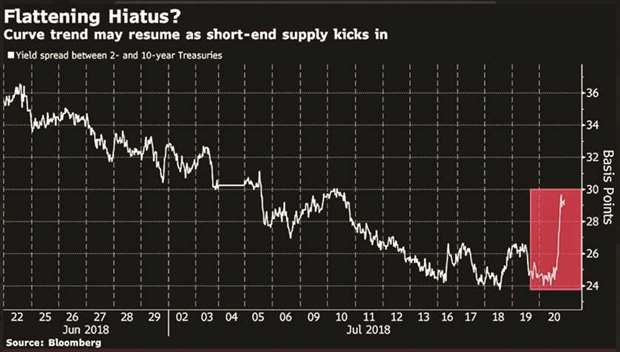The Treasury market is about to absorb $119bn of note auctions, all maturing in seven years or less. That means last week’s rare bout of yield-curve steepening may just be the pause that refreshes.
The spread between 2- and 10-year yields widened last week for the first time since June after US President Donald Trump expressed his displeasure with the Federal Reserve’s rate increases. Before Trump’s remarks, the curve was marching toward inversion, flattening to its narrowest level since 2007 after Fed chairman Jerome Powell reiterated the central bank’s commitment to gradually tighten policy.
The days ahead may reignite flattening bets as traders digest 2-, 5- and 7-year auctions, including floating-rate securities.
The fixed-rate portion will raise the most new cash since 2013. The US is also expected to report that gross domestic product grew at a 4.3% annualised clip last quarter, its strongest pace since 2014. While that’s before trade tension kicked into high gear, it may still reaffirm the economic backdrop for Powell’s plan to hike rates.
“Any in-range steepening is an opportunity to scale back into flatteners,” said Ian Lyngen, a rates strategist at BMO Capital Markets. “It’s difficult to fade the flattener given the Fed’s commitment to normalise rates in spite of relatively low core inflation and the potential economic headwinds from the trade war.”
The Treasury is selling $35bn of two-year notes, $18bn of two-year floating-rate notes, $36bn of five- year debt and $30bn of seven-year securities. The fixed-rate two-year is $1bn larger than last month’s, part of the department’s move to boost sale sizes as it plugs swelling deficits and makes up for the Fed’s shrinking balance sheet.
The Treasury has leaned toward shorter maturities as it increases issuance, contributing to the yield curve’s collapse. At about 30 basis points, the 2- to 10-year spread is down from almost 100 basis points a year ago.
On Aug. 1, the Treasury will unveil its latest borrowing plans. Wells Fargo Securities strategists estimate Treasury will increase the two- and three-year auctions by $1bn per month, and implement a one-time increase of $1bn for floating-rate notes as well as the five- through 30-year tenors. The pattern of increases would resemble Treasury’s announcement in May.
“It’s not the type of issuance schedule that would get us worried about pressure toward higher yields further out the curve,” Lyngen said.
The shape of the curve is drawing scrutiny because inversion has typically preceded US recessions.
Last week, St Louis Fed President James Bullard said that if long-term yields remain near present levels and the FOMC raises rates at the pace it forecast in June, the curve would invert in late 2018.
He also said Trump’s comments wouldn’t affect policy makers.
The Fed has raised rates twice this year and projects two more increases in 2018. Overnight index swaps are pricing in around 1.5 additional increases for this year.
Powell “sees a clear reason to continue rate hikes as well as balance-sheet reduction, so we don’t think there’s anything that will give him pause at the moment,” said Mona Mahajan, US investment strategist at Allianz Global Investors. She also sees inversion possible by year-end if the Fed sticks to its path.
With those expectations entrenched in the market, the effect of Trump’s remarks could dim.
“The knee-jerk reaction to Trump’s foray into monetary policy will fade rather quickly,” said BMO’s Lyngen. “The Fed will change policy when the economic reality suggests it’s time.”
What to watch this week
The US Trade Representative will hold a hearing on tariffs for $16bn in Chinese products on July 24, while the House of Representatives has a hearing on steel tariff exclusions.
The main event for US economic data is the first print of second-quarter GDP. July 23: Chicago Fed; existing home sales. July 24: FHFA home price index; Markit PMI; Richmond Fed. July 25: MBA mortgage applications; new home sales. July 26: Trade balance; wholesale inventories; jobless claims; durable goods; Bloomberg consumer comfort; Kansas City Fed. July 27: Second-quarter GDP; University of Michigan sentiment.

.


